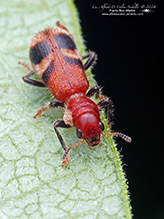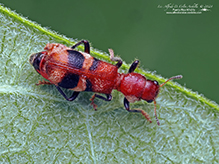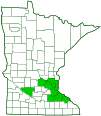reddish checkered beetle
(Enoclerus rosmarus)
Conservation • Description • Habitat • Ecology • Distribution • Taxonomy
|
|
||||||||||||||
Description |
Reddish checkered beetle is a common, small, predaceous beetle. It occurs in the United States east of the Great Plains and in southern Ontario Canada. Adults are active from May through July. They are found on herbaceous plants and on the branches of shrubs. They are generalist insect predators. Adults are ⅛″ to ¼″ (3.5 to 7.0 mm) in length. The body is robust and somewhat cylindrical in shape, elongate and narrow when viewed from above, convex when viewed from the front or from behind. It is completely covered with stiff, erect, bristly hairs. The base color (red) is somewhat variable, both between individuals and on the same individual: red, dark red, reddish brown, or orangish brown. The head and mouthparts are directed downward. The head is red, and it is as wide as the first segment of the thorax. The surface is finely and sparsely pitted (punctate). The compound eyes are bulging, and they are distinctly notched. The antennae have 11 segments. The last 3 segments are expanded and form a compact club. The club is somewhat abruptly enlarged. The finger-like sensory mouthparts (palps) are narrow. The exoskeletal plate covering the thorax (pronotum) is longer than wide and red. It is much narrower at the rear than the base of the wing covers (elytra). The surface is finely and densely punctate. There is a shallow but distinct transverse groove on the front half. The underside of the thorax is red. The elytra are wider than the pronotum, widest on the rear third. The surface is coarsely and densely punctate in front, becoming more finely punctate approaching the rear. The basal third is red, including in the shoulder (humeral) area. The middle third has three transverse bands, a narrow black band, followed by a broad pale band, followed by an even broader black band. The rear third is mostly pale but with a variable amount of black at the tips. The bands do not reach the inner margin. The underside of the abdomen is black. The legs may be red or black. The last part of each leg (tarsus), corresponding to the foot, has 5 segments. At the end of each tarsus there is a pair of claws and a hairy pad between the claws. The claws are of equal size, and they are toothed. |
Size |
Total length: ⅛″ to ¼″ (3.5 to 7.0 mm) |
Similar Species |
Habitat |
|
Ecology |
Season |
May through July |
Behavior |
|
Life Cycle |
|
Larva Food |
|
Adult Food |
|
Distribution |
||
|
Sources |
|
| 2/24/2025 | ||
Occurrence |
||
Common |
||
Taxonomy |
|
Order |
Coleoptera (Beetles) |
Suborder |
Polyphaga (Water, Rove, Scarab, Long-horned, Leaf, and Snout Beetles) |
Infraorder |
Cucujiformia |
Superfamily |
Cleroidea (bark-gnawing, checkered and soft-winged flower beetles) |
Family |
Cleridae (checkered beetles) |
Subfamily |
Clerinae |
Genus |
Enoclerus |
Subordinate Taxa |
|
|
|
Synonyms |
|
Clerus oculatus |
|
Common Names |
|
reddish checkered beetle |
|
Glossary
Elytra
The hardened or leathery forewings of beetles used to protect the fragile hindwings, which are used for flying. Singular: elytron.
Palp
Short for pedipalp. A segmented, finger-like process of an arthropod; one is attached to each maxilla and two are attached to the labium. They function as sense organs in spiders and insects, and as weapons in scorpions. Plural: palpi or palps.
Pronotum
The exoskeletal plate on the upper side of the first segment of the thorax of an insect.
Punctate
Dotted with pits (punctures), translucent sunken glands, or colored spots of pigment.
Tarsus
On insects, the last two to five subdivisions of the leg, attached to the tibia; the foot. On spiders, the last segment of the leg. Plural: tarsi.
Visitor Photos |
||
Share your photo of this insect. |
||
This button not working for you? |
||
Alfredo Colon |
||
 |
||
 |
 |
|
MinnesotaSeasons.com Photos |
||
|
||
|
||

Slideshows |
|

Visitor Videos |
||
Share your video of this insect. |
||
This button not working for you? |
||
|
Other Videos |
||
|

|
Created: 2/24/2025 Last Updated: © MinnesotaSeasons.com. All rights reserved. |



